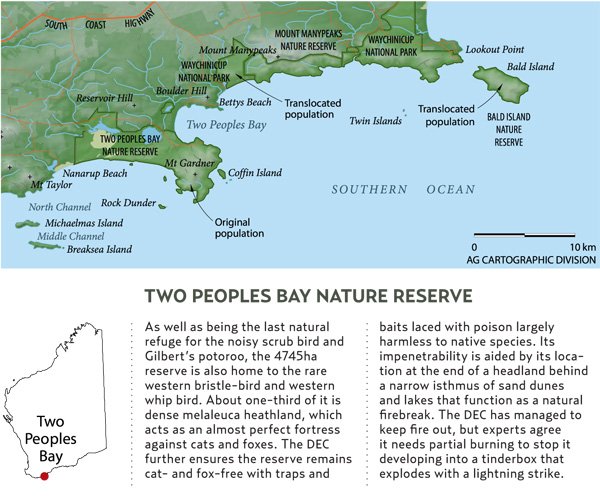Back from the dead: Gilbert’s potoroo

SHE’S KNOWN SIMPLY as 216. But she’s unquestionably special, and as the small, black bag is peeled back to reveal her long snout and large dark eyes she’s greeted with a hushed ripple of reverential “oohs” and “aahs”.
This is the 216th Gilbert’s potoroo to be counted since the species was rediscovered in 1994 after a century on our list of extinct mammals. One of just 100 that remain, this is arguably the world’s rarest marsupial: a rabbit-sized, wallaby-like, ball of soft fur that lives almost exclusively on native truffles.
We’re in a bush enclosure near Two Peoples Bay Nature Reserve, on the south coast of Western Australia. And the small audience being given this rare viewing includes volunteers who’ve been labouring to maintain the 8.2km predator-proof fence surrounding a new 380ha reserve, where 216 will eventually be released. “It’s such a privilege,” whispers Jonica Foss, of Perth, here to pull plants from around the fence to stop cats clambering over. “To think there are so few left and we’ve just seen one!”
The man who’s headed the recovery program since it began in 1999 is Dr Tony Friend, a scientist with WA’s Department of Environment and Conservation. When we last spoke to him about the potoroo’s plight (AG 88) there was little good news. The only natural population, at Two Peoples Bay, had been secured but was at maximum capacity of about 30. The species still hung on a knife edge with the real threat that one fire could wipe it out for good.
Gilbert’s potoroo is the comeback king
“We tried captive breeding,” Tony says. “And other things, like cross-fostering – using surrogates from another potoroo species to raise babies.” But all had proved expensive with little success.
Then, in 2005, the decision was made to risk a couple of adults to establish an ‘ark’ population on 800ha Bald Island, 25km east of Two Peoples Bay. It had already been used with success to build a population of noisy scrub birds, another species rediscovered in the 1960s at Two Peoples Bay (see map, below). The calculated gamble on Bald Island – which is free from the foxes and feral cats that have been largely responsible for the demise of Gilbert’s potoroo and so many other mammal and bird species – worked.
After 10 potoroos were released on Bald Island they began breeding, and by early 2010 numbers were great enough to start a second mainland population. Work finished on the new feral-free enclosure where 216 will eventually be released, and at the time of going to press there’d been three mainland releases of Bald Island potoroos and a fourth helicopter airlift of animals was being planned for later this year.
With the Gilbert’s potoroo population now at a little more than three times what it was when it was rediscovered in 1994 and spread across three locations, Tony’s finally comfortable in acknowledging the species has a good chance. “Although,” he cautions – after giving 216 a health check and gently releasing her back into her temporary bush home – “we’ve still got a long way to go.”

Source: Australian Geographic (Issue 108, May-June 2012)
RELATED STORIES




